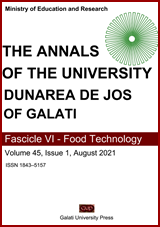Ultrasound and enzymatic assisted extractions of bioactive compounds found in red grape skins Băbească Neagră (Vitis vinifera) variety
Abstract
The phenolic composition of the skin of the Băbească neagră grapes grown in south-eastern Romania was studied by two extraction techniques, i. e., ultrasound-assisted extraction (UAE) and enzyme-assisted extraction (EAE). This study aimed to analyze the grape skin bioactive compounds and the antioxidant potential using ethanol of three different concentrations 50%, 70%, and 96% and acidified with acetic, citric acid, or hydrochloric acid. This research aimed to maximize the extraction of bioactive compounds from red grape skin by using commercially available oenological enzyme preparations, varying the enzyme dosage, pH, temperature and extraction time. The results indicated that the highest total anthocyanin content was obtained when using 70 % ethanol extract acidified with 0.1 N hydrochloric acid, characterized by 4.29±0.04 mg C3G/g DW for ultrasound extraction and 2.54±0.13 for enzyme-assisted extraction. The results of antioxidant potential of the extracts investigated showed that the 96% ethanol extract had the highest antioxidant activity (18.76±0.24 mM of Trolox/g DW), followed by the 50% ethanol extract and 70% ethanol extract (16.35±0.79 and 16.48±0.54 mM of Trolox/g DW, respectively). The results disclosed that the highest extraction yield for antioxidant activity quantification was obtained by cellulase (61.48±1.19 mMol Trolox / g DW) after only one hour of extraction.


